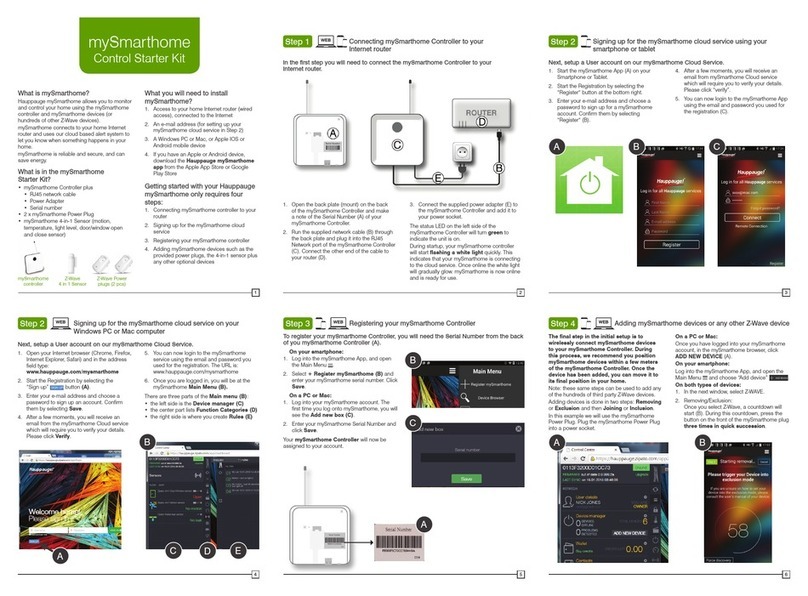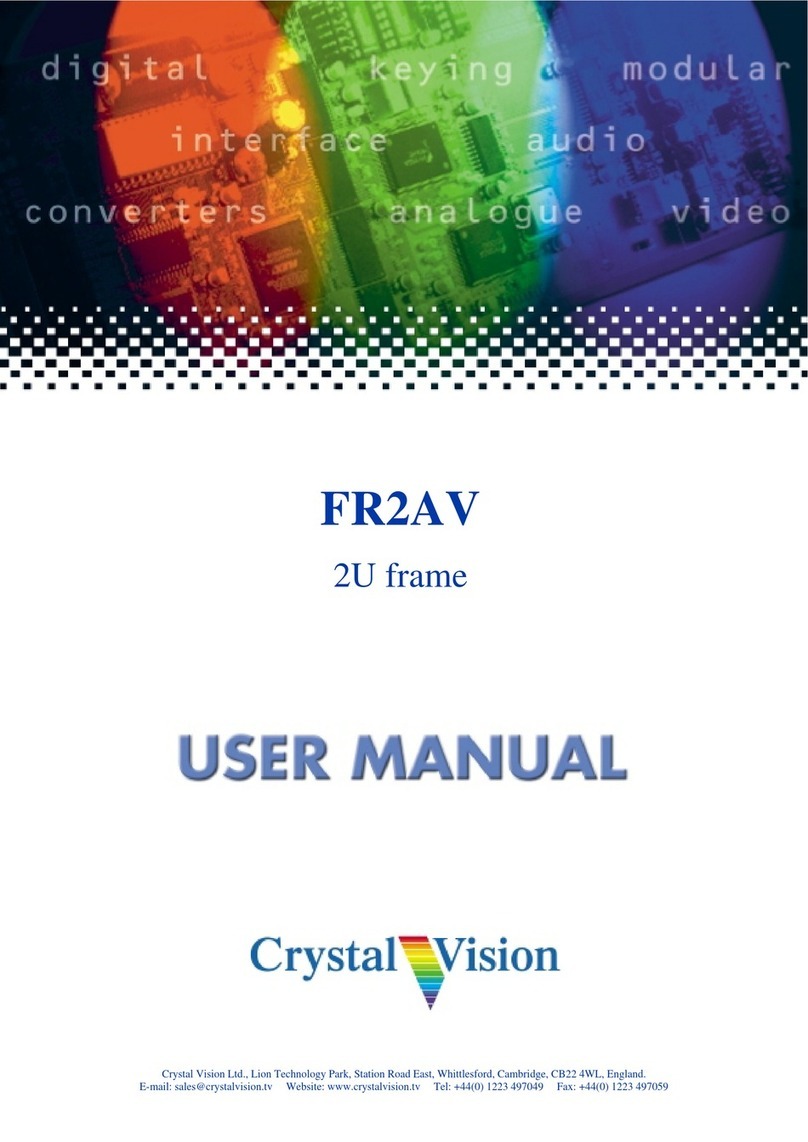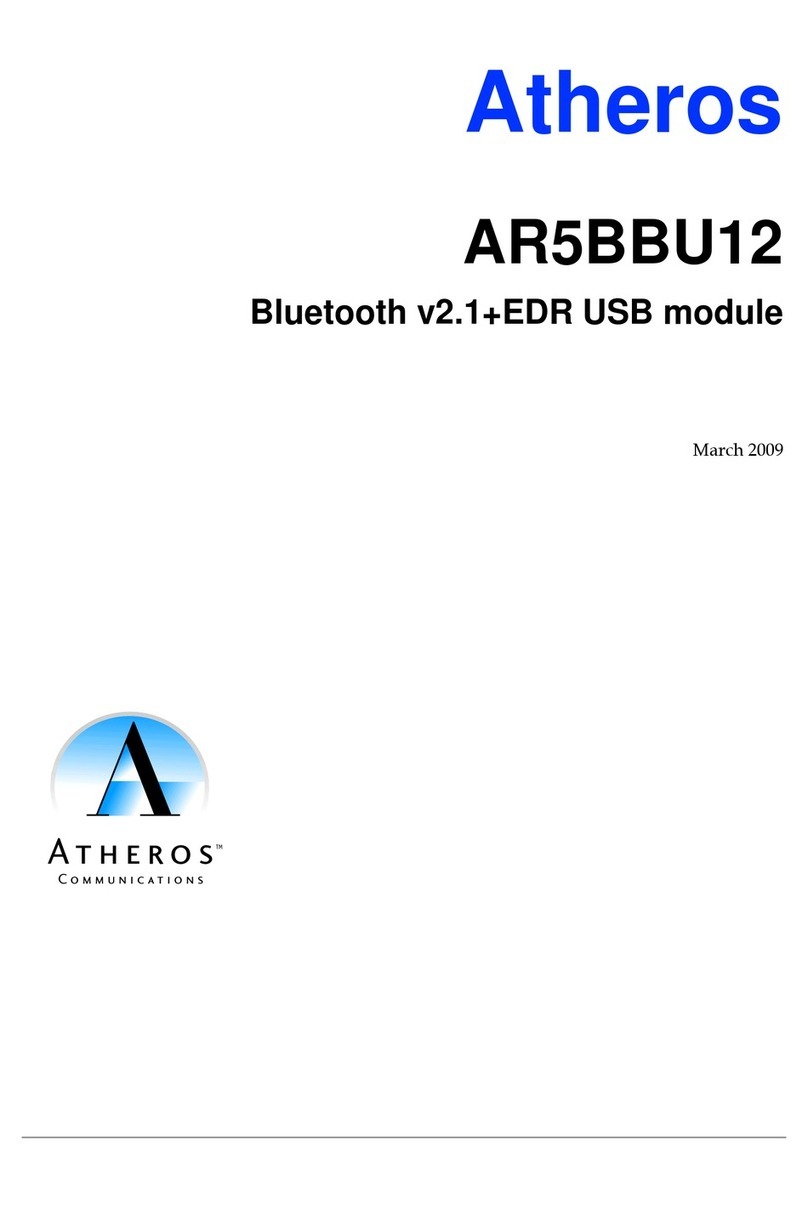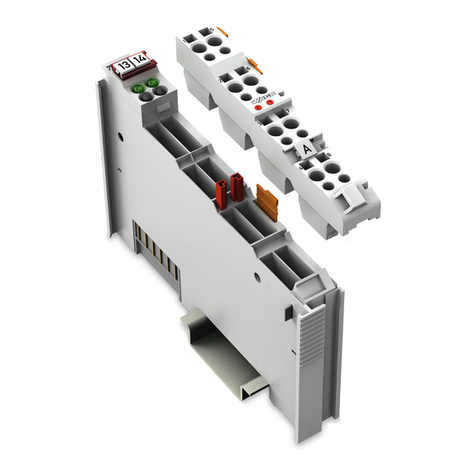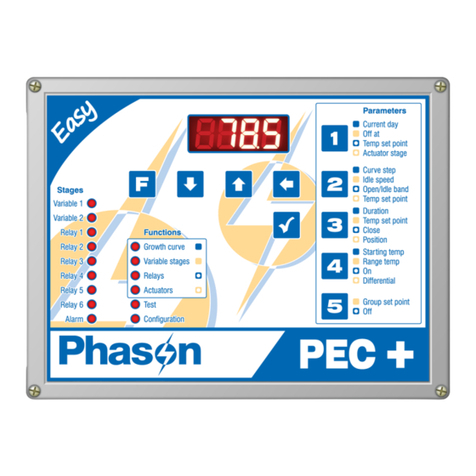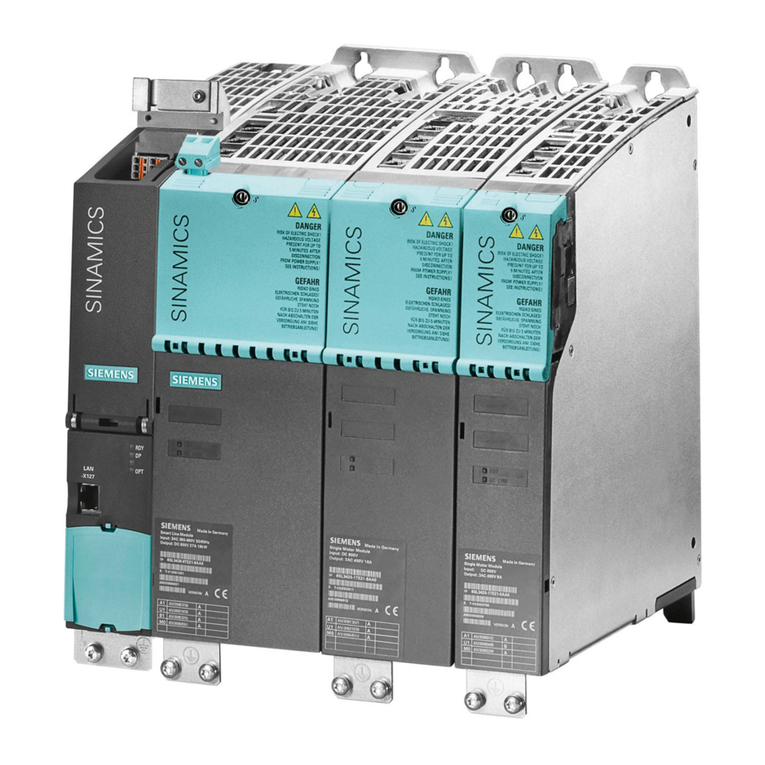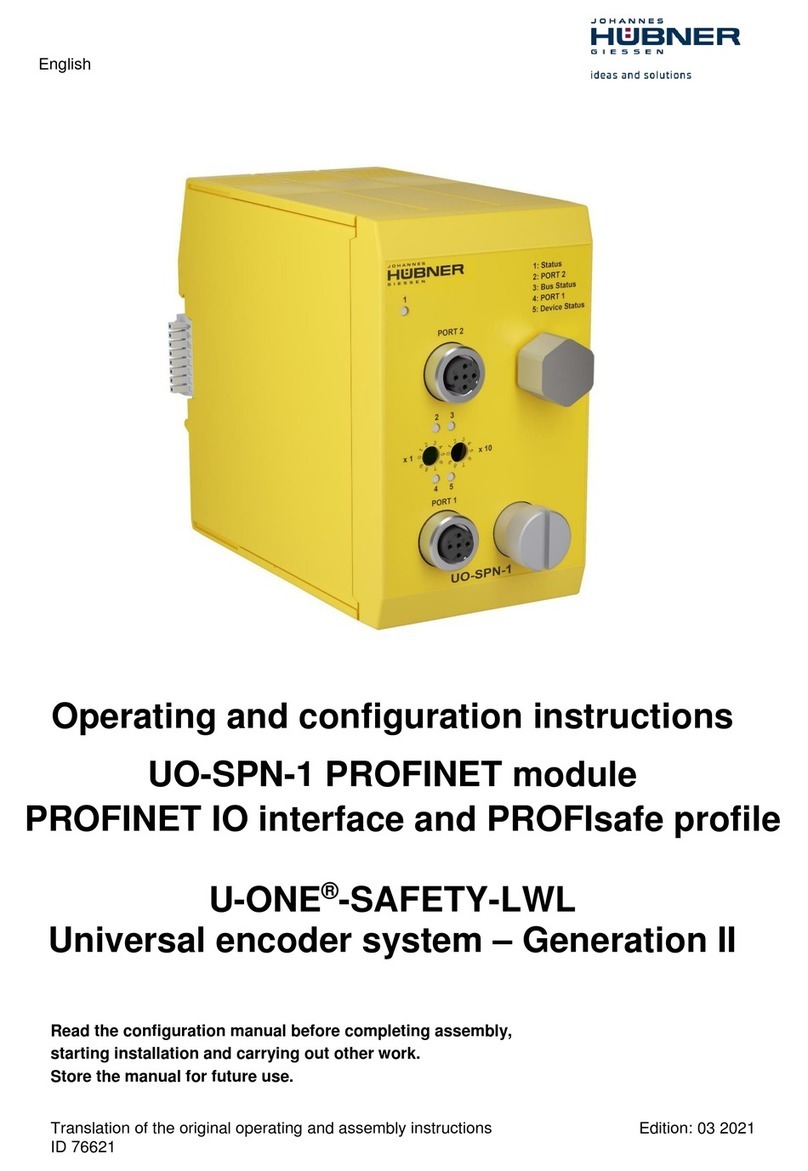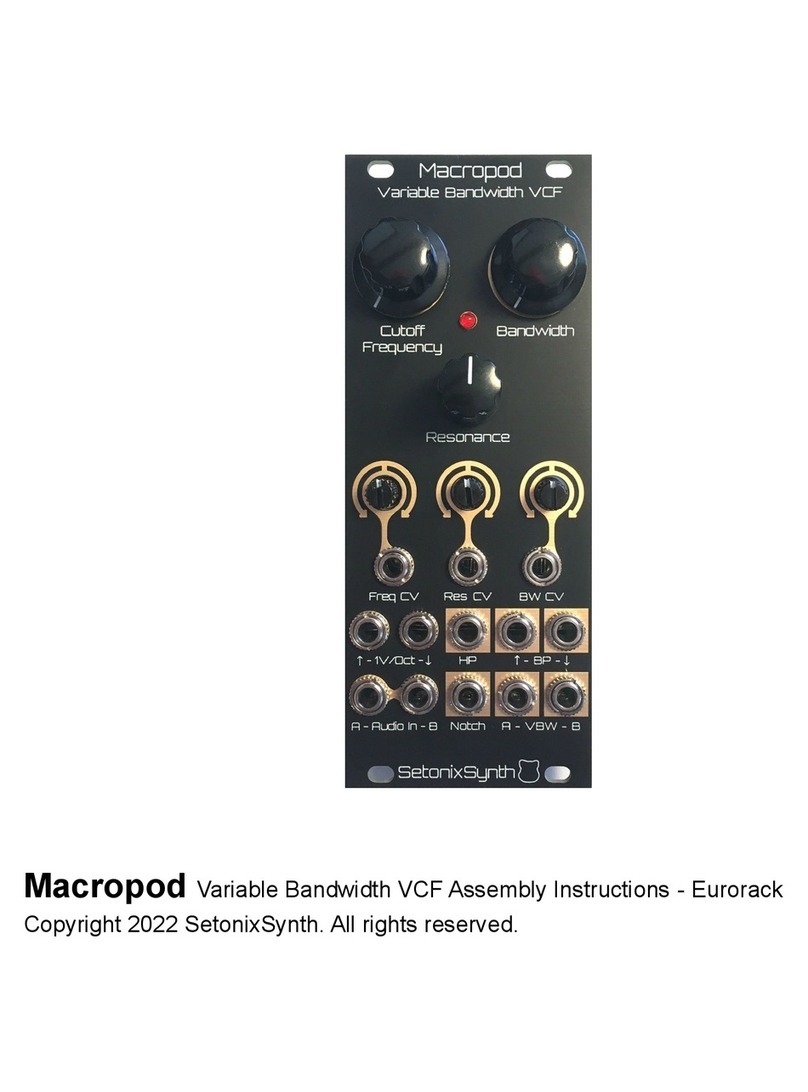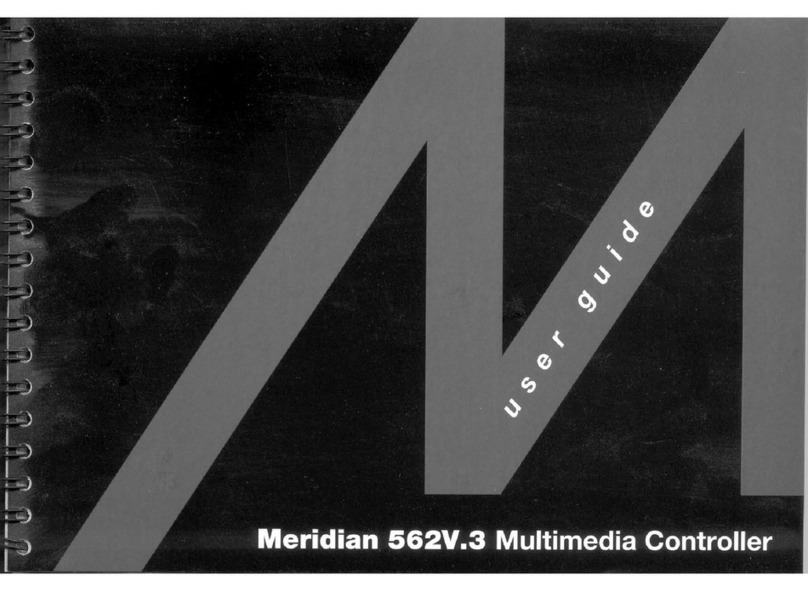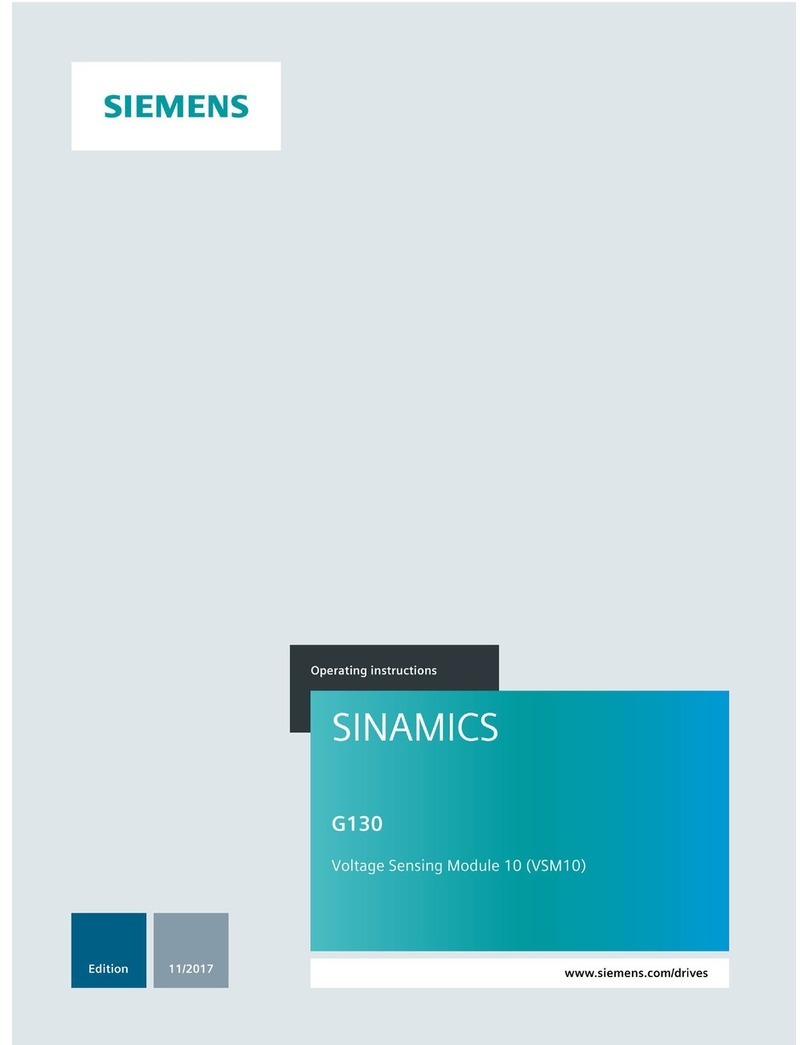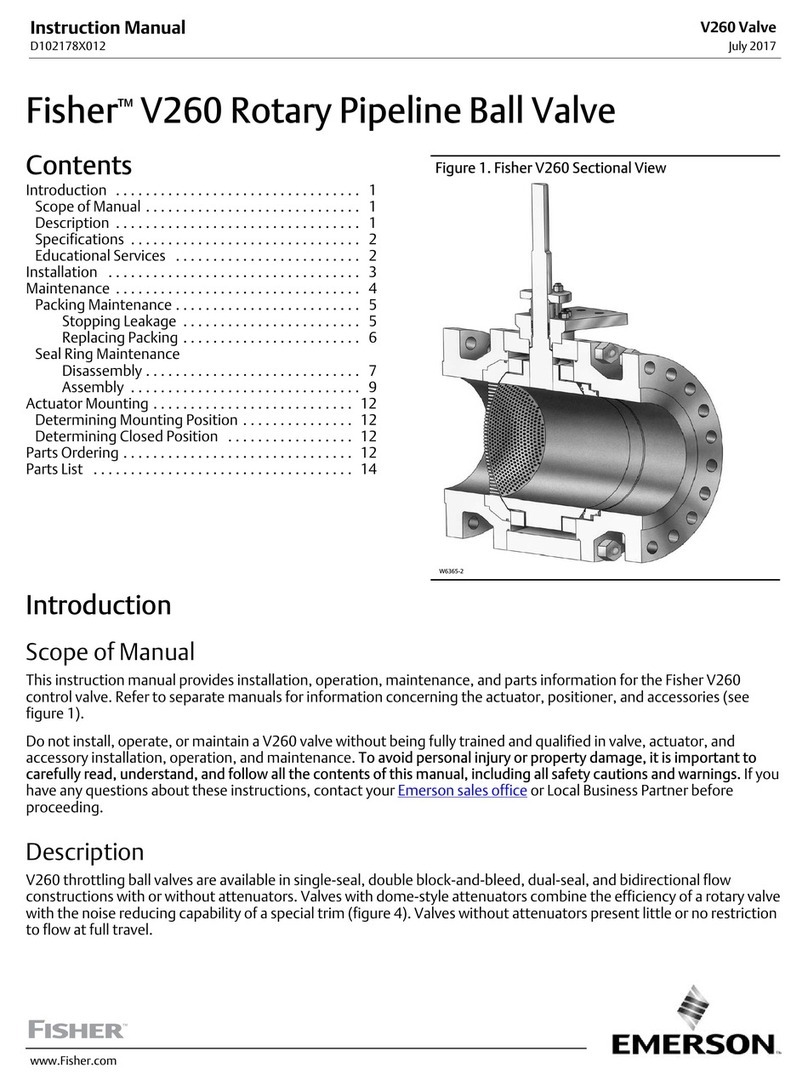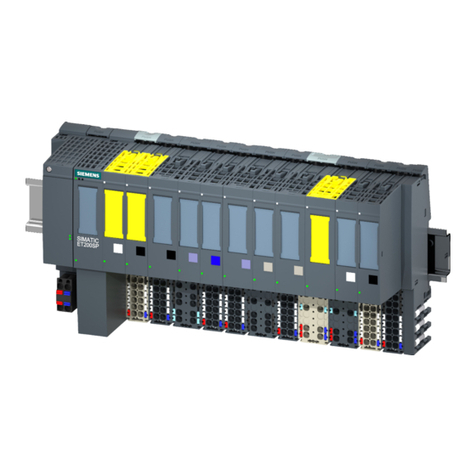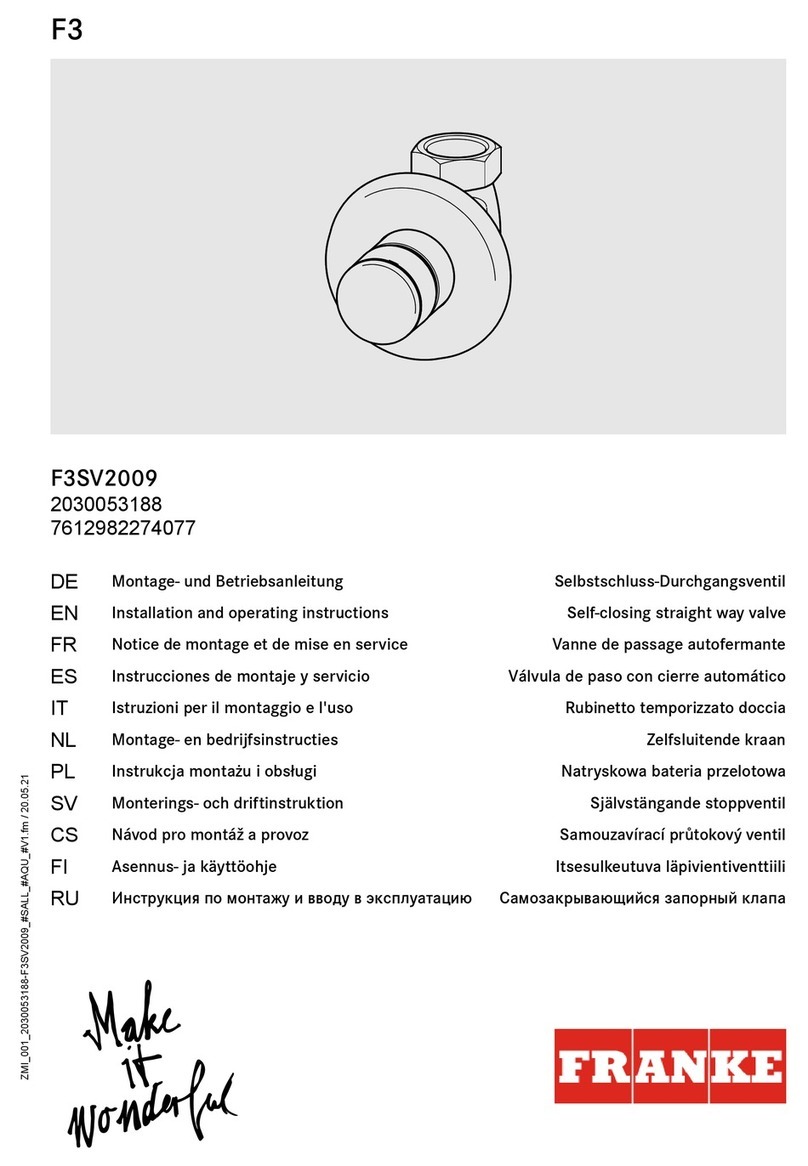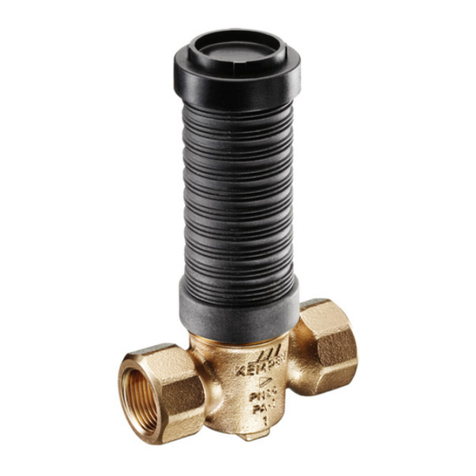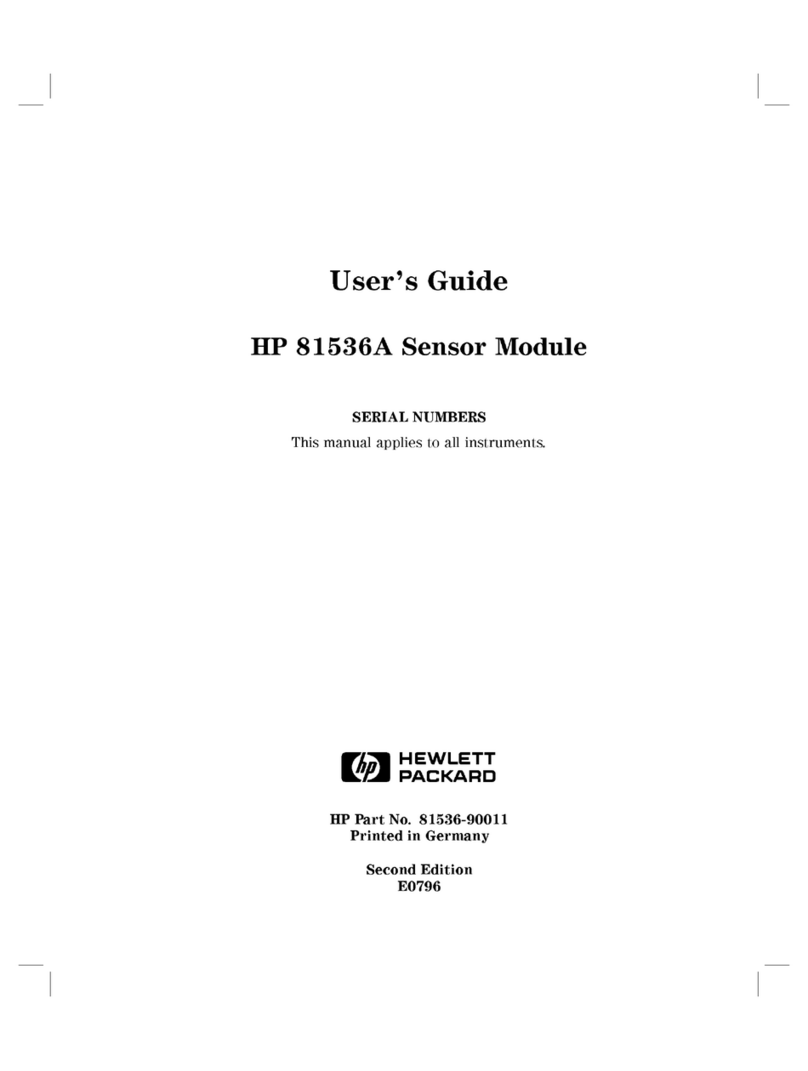Gemalto Cinterion EMS31-US Installation guide

GEMALTO.COM/M2M
Cinterion®EMS31-US
Hardware Interface Overview
Version: 00.103
DocId: EMS31_US_HIO_v00.103

GENERAL NOTE
THE USE OF THE PRODUCT INCLUDING THE SOFTWARE AND DOCUMENTATION (THE "PROD-
UCT") IS SUBJECT TO THE RELEASE NOTE PROVIDED TOGETHER WITH PRODUCT. IN ANY
EVENT THE PROVISIONS OF THE RELEASE NOTE SHALL PREVAIL. THIS DOCUMENT CONTAINS
INFORMATION ON GEMALTO M2M PRODUCTS. THE SPECIFICATIONS IN THIS DOCUMENT ARE
SUBJECT TO CHANGE AT GEMALTO M2M'S DISCRETION. GEMALTO M2M GMBH GRANTS A NON-
EXCLUSIVE RIGHT TO USE THE PRODUCT. THE RECIPIENT SHALL NOT TRANSFER, COPY,
MODIFY, TRANSLATE, REVERSE ENGINEER, CREATE DERIVATIVE WORKS; DISASSEMBLE OR
DECOMPILE THE PRODUCT OR OTHERWISE USE THE PRODUCT EXCEPT AS SPECIFICALLY
AUTHORIZED. THE PRODUCT AND THIS DOCUMENT ARE PROVIDED ON AN "AS IS" BASIS ONLY
AND MAY CONTAIN DEFICIENCIES OR INADEQUACIES. TO THE MAXIMUM EXTENT PERMITTED
BY APPLICABLE LAW, GEMALTO M2M GMBH DISCLAIMS ALL WARRANTIES AND LIABILITIES.
THE RECIPIENT UNDERTAKES FOR AN UNLIMITED PERIOD OF TIME TO OBSERVE SECRECY
REGARDING ANY INFORMATION AND DATA PROVIDED TO HIM IN THE CONTEXT OF THE DELIV-
ERY OF THE PRODUCT. THIS GENERAL NOTE SHALL BE GOVERNED AND CONSTRUED
ACCORDING TO GERMAN LAW.
Copyright
Transmittal, reproduction, dissemination and/or editing of this document as well as utilization of its con-
tents and communication thereof to others without express authorization are prohibited. Offenders will be
held liable for payment of damages. All rights created by patent grant or registration of a utility model or
design patent are reserved.
Copyright © 2017, Gemalto M2M GmbH, a Gemalto Company
Trademark Notice
Gemalto, the Gemalto logo, are trademarks and service marks of Gemalto and are registered in certain
countries. Microsoft and Windows are either registered trademarks or trademarks of Microsoft Corpora-
tion in the United States and/or other countries. All other registered trademarks or trademarks mentioned
in this document are property of their respective owners.
EMS31_US_HIO_v00.103 2017-11-27
Confidential / Preliminary
Cinterion®EMS31-US Hardware Interface Overview
2
Page 2 of 33
Document Name: Cinterion®EMS31-US Hardware Interface Overview
Version: 00.103
Date: 2017-11-27
DocId: EMS31_US_HIO_v00.103
Status: Confidential / Preliminary

Cinterion®EMS31-US Hardware Interface Overview
Contents
33
EMS31_US_HIO_v00.103 2017-11-27
Confidential / Preliminary
Page 3 of 33
Contents
1 Introduction.................................................................................................................6
1.1 Key Features at a Glance .................................................................................. 6
1.2 EMS31-US System Overview ............................................................................ 8
2 Interface Characteristics............................................................................................9
2.1 Application Interface .......................................................................................... 9
2.1.1 Serial Interface ASC0 ........................................................................... 9
2.1.2 Serial Interface ASC1 ......................................................................... 10
2.1.3 UICC/SIM/USIM Interface................................................................... 11
2.1.4 GPIO Interface .................................................................................... 13
2.1.5 Control Signals.................................................................................... 14
2.1.5.1 Status LED .......................................................................... 14
2.2 RF Antenna Interface....................................................................................... 14
2.2.1 Antenna Installation ............................................................................ 15
2.3 Sample Application .......................................................................................... 16
3 Operating Characteristics........................................................................................18
3.1 Operating Modes ............................................................................................. 18
3.2 Power Supply................................................................................................... 18
4 Mechanical Dimensions, Mounting and Packaging...............................................19
4.1 Mechanical Dimensions of EMS31-US ............................................................ 19
5 Regulatory and Type Approval Information...........................................................21
5.1 Directives and Standards................................................................................. 21
5.2 SAR requirements specific to portable mobiles ............................................... 23
5.3 Reference Equipment for Type Approval......................................................... 24
5.4 Compliance with FCC and ISED Rules and Regulations................................. 25
6 Document Information..............................................................................................27
6.1 Revision History ............................................................................................... 27
6.2 Related Documents ......................................................................................... 27
6.3 Terms and Abbreviations ................................................................................. 27
6.4 Safety Precaution Notes .................................................................................. 31
7 Appendix....................................................................................................................32
7.1 List of Parts and Accessories........................................................................... 32

Cinterion®EMS31-US Hardware Interface Overview
Ta bles
33
EMS31_US_HIO_v00.103 2017-11-27
Confidential / Preliminary
Page 4 of 33
Tables
Table 1: Signals of the SIM interface (SMT application interface) ............................... 11
Table 2: GPIO lines and possible alternative assignment............................................ 13
Table 3: Return loss in the active band........................................................................ 14
Table 4: Overview of operating modes ........................................................................ 18
Table 5: Directives ....................................................................................................... 21
Table 6: Standards of North American type approval .................................................. 21
Table 7: Standards of GCF and PTCRB type approval ............................................... 21
Table 8: Requirements of quality ................................................................................. 21
Table 9: Standards of the Ministry of Information Industry of the
People’s Republic of China............................................................................ 22
Table 10: Toxic or hazardous substances or elements with defined concentration
limits............................................................................................................... 22
Table 11: Antenna gain limits for FCC and ISED........................................................... 25
Table 12: List of parts and accessories.......................................................................... 32
Table 13: Molex sales contacts (subject to change) ...................................................... 32

Cinterion®EMS31-US Hardware Interface Overview
Figures
33
EMS31_US_HIO_v00.103 2017-11-27
Confidential / Preliminary
Page 5 of 33
Figures
Figure 1: EMS31-US system overview............................................................................ 8
Figure 2: Serial interface ASC0....................................................................................... 9
Figure 3: Serial interface ASC1..................................................................................... 10
Figure 4: External UICC/SIM/USIM card holder circuit ................................................. 12
Figure 5: Schematic diagram of EMS31-US sample application................................... 17
Figure 6: EMS31-US - top and bottom view.................................................................. 19
Figure 7: Dimensions of EMS31-US (all dimensions in mm) ........................................ 20
Figure 8: Dimensions of EMS31-US (all dimensions in mm) - bottom view .................. 20
Figure 9: Reference equipment for Type Approval ....................................................... 24

Cinterion®EMS31-US Hardware Interface Overview
1 Introduction
8
EMS31_US_HIO_v00.103 2017-11-27
Confidential / Preliminary
Page 6 of 33
1 Introduction
This document1describes the hardware of the Cinterion®EMS31-US module. It helps you
quickly retrieve interface specifications, electrical and mechanical details and information on
the requirements to be considered for integrating further components.
The EMS31-US module includes a baseband, a complete dual band RF front-end, memory and
required circuitry to meet the 3GPP E-UTRA Long Term Evolution - LTE, Release 13 CAT M1
set of specifications.
1.1 Key Features at a Glance
1. The document is effective only if listed in the appropriate Release Notes as part of the technical docu-
mentation delivered with your Gemalto M2M product.
Feature Implementation
General
Frequency bands LTE Triband: B2, B4, B12
Output power Class 3 (+23dBm +-2dB) for LTE 1900, LTE HD-FDD B2
Class 3 (+23dBm +-2dB) for LTE AWS, LTE HD-FDD B4
Class 3 (+23dBm +-2dB) for LTE 700, LTE HD-FDD B12
Power supply 3.2V to 5.5V
Operating temperature
(board temperature)
Normal operation: -30°C to +85°C
Extended operation: -40°C to +95°C
Physical Dimensions: 27.60mm x 18.80mm x 2.05mm
Weight: approx. 2.2g
RoHS All hardware components fully compliant with EU RoHS Directive
LTE features
3GPP Release 13 DL 300 kbps, UL 375 kbps
LTE Cat. M1 data rates
SMS Point-to-point MT and MO
Text mode
Storage in mobile equipment
Software
AT commands Hayes, 3GPP TS 27.007, TS 27.005, product specific
SIM Application Toolkit SAT Release 99
Firmware update Generic update from host application over ASC0
OTA over ASC0

Cinterion®EMS31-US Hardware Interface Overview
1.1 Key Features at a Glance
8
EMS31_US_HIO_v00.103 2017-11-27
Confidential / Preliminary
Page 7 of 33
Interfaces
Module interface Surface mount device with solderable connection pads (SMT application
interface). Land grid array (LGA) technology ensures high solder joint reli-
ability and allows the use of an optional module mounting socket.
For more information on how to integrate SMT modules see also [3]. This
application note comprises chapters on module mounting and application
layout issues as well as on SMT application development equipment.
2 serial interfaces ASC0:
• 8-wire modem interface with status and control lines, unbalanced, asyn-
chronous
• Default baud rate: 115,200 baud
• Adjustable baud rates: 1,200 to 3,686,400
• Supports RTS0/CTS0 hardware flow control.
• Indication of incoming data/SMS on RING0 (can be used to wake up
host from power down modes)
ASC1 (shared with GPIO lines):
• 4-wire, unbalanced asynchronous interface
• Default baud rate: 115,200 baud
• Adjustable baud rates: 1,200 to 3,686,400bps
• Supports RTS1/CTS1 hardware flow control
UICC interface Supported SIM/USIM cards: 3V, 1.8V
Embedded UICC Module is hardware prepared for an embedded UICC (MIM)
GPIO interface 20 pads of the application interface programmable as GPIO pads (17) or
GPO pads (3):
GP(I)Os can be configured as ASC0 andASC1
Programming is done via AT commands
Antenna interface pad 50ΩLTE antenna
Power on/off, Reset
Power on/off Switch-on by hardware signal ON
Switch-off by AT command
Automatic switch-off in case of critical temperature and voltage conditions
Reset Orderly shutdown and reset by AT command
Evaluation kit
Evaluation module EMS31-US module soldered onto a dedicated PCB that can be connected
to an adapter in order to be mounted onto the DSB75.
DSB75 DSB75 Development Support Board designed to test and type approve
Gemalto M2M modules and provide a sample configuration for application
engineering. A special adapter is required to connect the EMS31-US evalu-
ation module to the DSB75.
Feature Implementation

Cinterion®EMS31-US Hardware Interface Overview
1.2 EMS31-US System Overview
8
EMS31_US_HIO_v00.103 2017-11-27
Confidential / Preliminary
Page 8 of 33
1.2 EMS31-US System Overview
Note: The following features are not yet available with the current product release: GPIO, I2C, Pulse Count-
er, PWM, FST_SHDN, SPI, ADC and 2nd SIM/MIM. Second SIM/MIM interface is hardware prepared
only.
Figure 1: EMS31-US system overview
GPIO
interface
I2C
ASC0
CONTROL
POWER
ANTENNA
(LTE band)
Module
SIM1 interface
(with SIM detection)
SIM1
Application
BATT+
V180
VCORE
Emergency reset
ON
Serial modem
interface
I2C
4
4
1
1
1
Antenna
1
7
Status LED
1
FST_SHDN Fast shutdown
1
1
ADC ADC
1
COUNTER
PWM
1
GP(I)Os
SPI SPI
2
ASC1 Serial interface
4
5
1
SIM2 interface/MIM
(with SIM detection)
SIM2 /MIM
1
5
PWM
4
4
Pulse Counter
1
1
1
2
3
2
1
1
1

Cinterion®EMS31-US Hardware Interface Overview
2 Interface Characteristics
17
EMS31_US_HIO_v00.103 2017-11-27
Confidential / Preliminary
Page 9 of 33
2 Interface Characteristics
EMS31-US is equipped with an SMT application interface that connects to the external appli-
cation. The SMT application interface incorporates the various application interfaces as well as
the RF antenna interfaces.
2.1 Application Interface
2.1.1 Serial Interface ASC0
EMS31-US offers an 8-wire unbalanced, asynchronous modem interface ASC0 conforming to
ITU-T V.28 protocol DCE signaling. The electrical characteristics do not comply with ITU-T
V.28. The significant levels are 0V (for low data bit or active state) and 1.8V (for high data bit
or inactive state).
EMS31-US is designed for use as a DCE. Based on the conventions for DCE-DTE connections
it communicates with the customer application (DTE) using the following signals:
• Port TXD @ application sends data to the module’s TXD0 signal line
• Port RXD @ application receives data from the module’s RXD0 signal line
Figure 2: Serial interface ASC0
Features:
• Includes the data lines TXD0 and RXD0, the status lines RTS0 and CTS0 and, in addition,
the modem control lines DTR0, DSR0, DCD0 and RING0.
• Configured for 8 data bits, no parity and 1 stop bit.
• ASC0 can be operated at fixed bit rates from 1,200bps up to 3,686,400bps.
• Autobauding (supported by future firmware version)
• Supports RTS0/CTS0 hardware flow control. Communication is possible by using only RXD
and TXD lines, if RTS0 is pulled low.

Cinterion®EMS31-US Hardware Interface Overview
2.1 Application Interface
17
EMS31_US_HIO_v00.103 2017-11-27
Confidential / Preliminary
Page 10 of 33
2.1.2 Serial Interface ASC1
EMS31-US provides a 4-wire unbalanced, asynchronous modem interface ASC1 conforming
to ITU-T V.24 protocol DCE signaling. The electrical characteristics do not comply with ITU-T
V.28. The significant levels are 0V (for low data bit or active state) and 1.8V (for high data bit
or inactive state).
EMS31-US is designed for use as a DCE. Based on the conventions for DCE-DTE connections
it communicates with the customer application (DTE) using the following signals:
• Port TXD @ application sends data to module’s TXD1 signal line
• Port RXD @ application receives data from the module’s RXD1 signal line
Figure 3: Serial interface ASC1
Features
• Includes only the data lines TXD1 and RXD1 plus RTS1 and CTS1 for hardware hand-
shake.
• On ASC1 no RING line is available.
• Configured for 8 data bits, no parity and 1 or 2 stop bits.
• ASC1 can be operated at fixed bit rates from 1,200 bps to 3,686,400bps.
• Supports RTS1/CTS1 hardware flow control. Communication is possible by using only RXD
and TXD lines, if RTS1 is pulled low.
TXD1
RXD1
RTS1
CTS1
TXD
RXD
RTS
CTS
Module(DCE) Application (DCE)

Cinterion®EMS31-US Hardware Interface Overview
2.1 Application Interface
17
EMS31_US_HIO_v00.103 2017-11-27
Confidential / Preliminary
Page 11 of 33
2.1.3 UICC/SIM/USIM Interface
EMS31-US has two identical integrated UICC/SIM/USIM interfaces compatible with the 3GPP
31.102 and ETSI 102 221. These two interfaces are mutually exclusive, meaning that only one
UICC/SIM/USIM interface can be used at a time. This interface is wired to the host interface in
order to be connected to an external SIM card holder. Five pads on the SMT application inter-
face are reserved for each SIM interface.
The UICC/SIM/USIM interface supports 3V and 1.8V SIM cards.
The CCINx signal serves to detect whether a tray (with SIM card) is present in the card holder.
The CCINx signal must be connected to V180 for the detection to work on the module. Other-
wise the SIM card can never be detected by the module.
Using the CCINx signal is mandatory for compliance with the GSM 11.11 recommendation if
the mechanical design of the host application allows the user to remove the SIM card during
operation. To take advantage of this feature, an appropriate SIM card detect switch is required
on the card holder. For example, this is true for the model supplied by Molex, which has been
tested to operate with EMS31-US and is part of the Gemalto M2M reference equipment sub-
mitted for type approval. See Section 7.1 for Molex ordering numbers.
Note: No guarantee can be given, nor any liability accepted, if loss of data is encountered after
removing the SIM card during operation. Also, no guarantee can be given for properly initializ-
ing any SIM card that the user inserts after having removed the SIM card during operation. In
this case, the application must restart EMS31-US.
Table 1: Signals of the SIM interface (SMT application interface)
Signal Description
GND Separate ground connection for SIM card to improve EMC.
CCCLKx Chipcard clock
CCVCCx SIM supply voltage.
CCIOx Serial data line, input and output.
CCRSTx Chipcard reset
CCINx Input on the baseband processor for detecting a SIM card tray in the holder. If the SIM is
removed during operation the SIM interface is shut down immediately to prevent destruc-
tion of the SIM. The CCINx signal is by default low and will change to high level if a SIM
card is inserted.
The CCINx signal is mandatory for applications that allow the user to remove the SIM card
during operation.
The CCINx signal is solely intended for use with a SIM card. It must not be used for any
other purposes. Failure to comply with this requirement may invalidate the type approval of
EMS31-US.
Pull-down 220k resistor is mandatory.

Cinterion®EMS31-US Hardware Interface Overview
2.1 Application Interface
17
EMS31_US_HIO_v00.103 2017-11-27
Confidential / Preliminary
Page 12 of 33
The figure below shows a circuit to connect an external SIM card holder.
Figure 4: External UICC/SIM/USIM card holder circuit
The total cable length between the SMT application interface pads on EMS31-US and the pads
of the external SIM card holder must not exceed 100mm in order to meet the specifications of
3GPP TS 51.010-1 and to satisfy the requirements of EMC compliance.
To avoid possible cross-talk from the CCCLKx signal to the CCIOx signal be careful that both
lines are not placed closely next to each other. A useful approach is using a GND line to shield
the CCIOx line from the CCCLKx line.
SIM
CCVCC
CCRST
CCIO
CCCLK
220nF
1nF
CCIN
V180
R 220k
Switch position (SIM inserted )
Switch position(SIM
not inserted)

Cinterion®EMS31-US Hardware Interface Overview
2.1 Application Interface
17
EMS31_US_HIO_v00.103 2017-11-27
Confidential / Preliminary
Page 13 of 33
2.1.4 GPIO Interface
EMS31-US offers a GPIO interface with 20 GPIO lines. The lines are shared with other inter-
faces or functions: ASC0 (see Section 2.1.1), ASC1 (see Section 2.1.2),
The following table shows the configuration variants for the GPIO pads. All variants are mutu-
ally exclusive, i.e. a pad configured for instance as ASC0 is locked for alternative usage.
*) Note: The following features are not yet available with the current product release: GPIO, I2C, Pulse
Counter, PWM, FST_SHDN and SPI.
After startup, the above mentioned alternative GPIO line assignments can be configured using
AT commands (see [1]). The configuration is non-volatile and available after module restart.
Table 2: GPIO lines and possible alternative assignment
GPIO* Fast
Shut-
down*
Status
LED Pulse
Counter* ASC0 ASC1 SPI* PWM* WAKE
capability
GPIO1 DTR0 Available
GPIO2 DCD0
GPIO3 DSR0
GPIO4 FST_SHD
N
GPO5 LED
GPIO6 PWM2
GPIO7 PWM1
GPIO8 COUNTER Available
GPIO16 RXD1
GPIO17 TXD1
GPIO18 RTS1 Available
GPIO19 CTS1
GPIO20
GPIO21
GPIO22
GPO23
GPIO24 RING0
GPIO25 Available
GPO26 SPI_CS
1
GPIO27 SPI_CS
2
n/a RST0 Available

Cinterion®EMS31-US Hardware Interface Overview
2.2 RF Antenna Interface
17
EMS31_US_HIO_v00.103 2017-11-27
Confidential / Preliminary
Page 14 of 33
2.1.5 Control Signals
2.1.5.1 Status LED
Note that this feature is not available with release 1.
The LED line can also be configured as GPO5 line, and can be used to drive a status LED that
indicates different operating modes of the module (for GPOs see Section 2.1.4). LED and
GPIO5 functionality are mutually exclusive.
2.2 RF Antenna Interface
The RF interface has an impedance of 50Ω. EMS31-US is capable of sustaining a 10:1 voltage
standing wave ratio (VSWR) mismatch at the antenna line without any damage, even when
transmitting at maximum RF power.
The external antenna must be matched properly to achieve best performance regarding radi-
ated power, modulation accuracy and harmonic suppression. Antenna matching networks are
not included on the EMS31-US module and should be placed in the host application if the an-
tenna does not have an impedance of 50Ω.
Regarding the return loss EMS31-US provides the following values in the active band:
Table 3: Return loss in the active band
State of module Return loss of module Recommended return loss of application
Receive > 8dB > 12dB
Transmit not applicable > 12dB

Cinterion®EMS31-US Hardware Interface Overview
2.2 RF Antenna Interface
17
EMS31_US_HIO_v00.103 2017-11-27
Confidential / Preliminary
Page 15 of 33
2.2.1 Antenna Installation
The antenna is connected by soldering the antenna pad (RF_OUT, pad #59) its neighboring
ground pads (GND, i.e., pads #58 and #60) directly to the application's PCB. The antenna pad
is the antenna reference point (ARP) for EMS31-US. All RF data specified throughout this doc-
ument is related to the ARP.
The distance between the antenna RF pads and its neighboring GND pads has been optimized
for best possible impedance. On the application PCB, special attention should be paid to these
3 pads, in order to prevent mismatch.
The wiring of the antenna connection line, starting from the antenna pad to the application an-
tenna should result in a 50Ωline impedance. Line width and distance to the GND plane needs
to be optimized with regard to the PCB’s layer stack.
To prevent receiver desensitization due to interferences generated by fast transients like high
speed clocks on the application PCB, it is recommended to realize the antenna connection line
using embedded Stripline rather than Microstrip line technology.
For type approval purposes an external application must connect the RF signal in one of the
following ways:
•Via50
Ωcoaxial antenna connector (common connectors are U-FL or SMA) placed as close
as possible to the module's antenna pad.
• By soldering the antenna to the antenna connection line on the application’s PCB (without
the use of any connector) as close as possible to the module’s antenna pad.
• By routing the application PCB's antenna to the module’s antenna pad in the shortest way.
In case FCC certification of application using EMS31-US is required, the implementation of the
connection between module's antenna pad and antenna has to be designed similar to the im-
plementation of this connection on evaluation board and according to KDB 996369 related to
modular approval requirements.

Cinterion®EMS31-US Hardware Interface Overview
2.3 Sample Application
17
EMS31_US_HIO_v00.103 2017-11-27
Confidential / Preliminary
Page 16 of 33
2.3 Sample Application
Figure 5 shows a typical example of how to integrate an EMS31-US module with an application.
Usage of the various host interfaces depends on the desired features of the application.
Because of the high RF field density inside the module, it cannot be guaranteed that no self
interference might occur, depending on frequency and the applications grounding concept. The
potential interferers may be minimized by placing small capacitors (47pF) at suspected lines
(e.g. RXD0, or ON).
While developing SMT applications it is strongly recommended to provide test points
for certain signals, i.e., lines to and from the module - for debug and/or test purposes.
The SMT application should allow for an easy access to these signals. For details on
how to implement test points see [3].
The EMC measures are best practice recommendations. In fact, an adequate EMC strategy for
an individual application is very much determined by the overall layout and, especially, the po-
sition of components.
Note: EMS31-US is not intended for use with cables longer than 3m.
Disclaimer: No warranty, either stated or implied, is provided on the sample schematic diagram
shown in Figure 5 and the information detailed in this section. As functionality and compliance
with national regulations depend to a great amount on the used electronic components and the
individual application layout manufacturers are required to ensure adequate design and oper-
ating safeguards for their products using EMS31-US module.

Cinterion®EMS31-US Hardware Interface Overview
2.3 Sample Application
17
EMS31_US_HIO_v00.103 2017-11-27
Confidential / Preliminary
Page 17 of 33
Note: The following features are not yet available with the current product release: GPIO, I2C, Pulse Count-
er, PWM, FST_SHDN, SPI, ADC and 2nd SIM/MIM. Second SIM/MIM interface is hardware prepared
only.
Figure 5: Schematic diagram of EMS31-US sample application
EMS31-US
Antenna
BATT+
GPIOs
LED
COUNTER
PWMs
I2CCLK
I2CDAT
GND
V180
CCIN
CCVCC
CCIO
CCRST
CCCLK
V180
CCIN2
CCVCC2
CCIO2
CCRST2
CCCLK2
ON
FST_SHDN
ASC0
ASC1
Power Supply
47µF47µF100pF
2k2 2k2
V180
µC
1nF 10pF10pF220nF
SIM2
SIM1
220nF 10pF
1nF
10pF
R220k
R220k

Cinterion®EMS31-US Hardware Interface Overview
3 Operating Characteristics
18
EMS31_US_HIO_v00.103 2017-11-27
Confidential / Preliminary
Page 18 of 33
3 Operating Characteristics
3.1 Operating Modes
The table below briefly summarizes the various operating modes referred to throughout the
document.
3.2 Power Supply
The power supply of EMS31-US has to be a single voltage source at BATT+. It must be able
to provide the current for all operation modes of the module.
All the key functions for supplying power to the device are handled by the power management
section of the analog controller. This IC provides the following features:
• Stabilizes the supply voltages for the baseband using low drop linear voltage regulators and
a DC-DC step down switching regulator.
• Switches the module's power voltages for the power-up and -down procedures.
• SIM switch to provide SIM power supply.
Table 4: Overview of operating modes
Mode Function
Normal
opera-
tion
Active TX LTE data transfer in progress. Power consumption depends on network
settings, data transfer rate and radio conditions.
No data transfer is in progress and no active communication via ASC0/
ASC1.
IDLE No data transfer is in progress. The LTE part of the device can be in
LTE DRX, LTE eDRX or LTE PSM mode. Activity on ASC0 /ASC1 inter-
faces can be present. Power consumption depends on the LTE power
saving mode and its parameters and on the activity on the ASC inter-
faces.
Sleep The module is in low power consumption state. There is no activity inside the module but
module preserves the state in which it was before entering the sleep mode, including the
electrical states of the GPIOs. The module will enter sleep state only when the LTE part of
the module is in LTE DRX, LTE eDRX or LTE PSM mode or if it is in airplane mode. To
allow sleep mode the host application shall indicate via RTS lines that it has no intention to
send data.
Power
Down
Normal shutdown after sending the power down command. Software is not active. Inter-
faces are not accessible. Operating voltage remains applied.
Airplane
mode
Airplane mode shuts down the radio part of the module, causes the module to log off from
the LTE network and disables all AT commands whose execution requires a radio connec-
tion.
Airplane mode can be controlled by AT command (see [1]).
Sleep mode can be entered when airplane mode is enabled.

Cinterion®EMS31-US Hardware Interface Overview
4 Mechanical Dimensions, Mounting and Packaging
20
EMS31_US_HIO_v00.103 2017-11-27
Confidential / Preliminary
Page 19 of 33
4 Mechanical Dimensions, Mounting and Packaging
The following sections describe the mechanical dimensions of EMS31-US and give recommen-
dations for integrating EMS31-US into the host application.
4.1 Mechanical Dimensions of EMS31-US
Figure 6 shows the top and bottom view of EMS31-US and provides an overview of the board's
mechanical dimensions. For further details see Figure 7.
Figure 6: EMS31-US - top and bottom view
Product label
Top view
Bottom view

Cinterion®EMS31-US Hardware Interface Overview
4.1 Mechanical Dimensions of EMS31-US
20
EMS31_US_HIO_v00.103 2017-11-27
Confidential / Preliminary
Page 20 of 33
Figure 7: Dimensions of EMS31-US (all dimensions in mm)
Figure 8: Dimensions of EMS31-US (all dimensions in mm) - bottom view
Table of contents
Other Gemalto Control Unit manuals
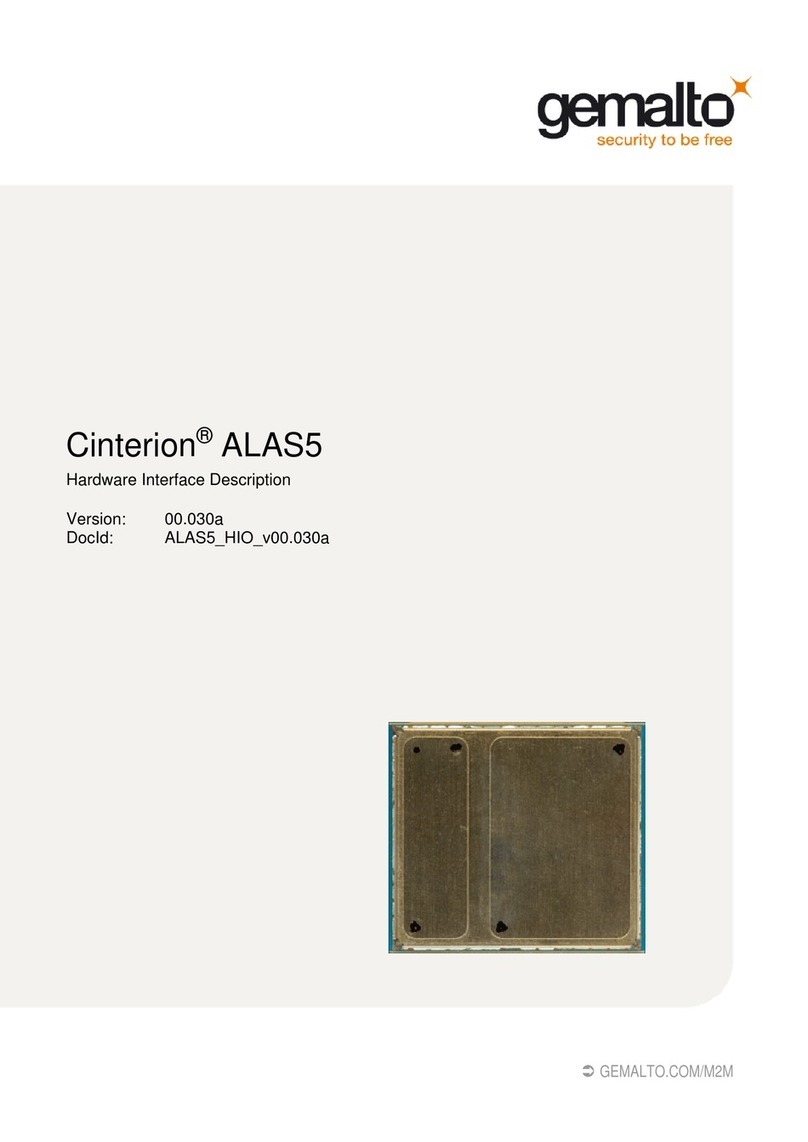
Gemalto
Gemalto Cinterion ALAS5 User manual
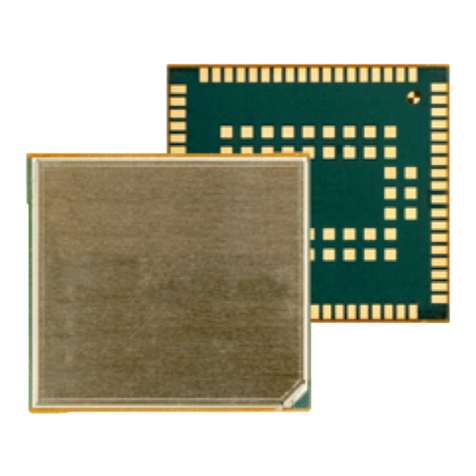
Gemalto
Gemalto Cinterion EHS6 Installation instructions
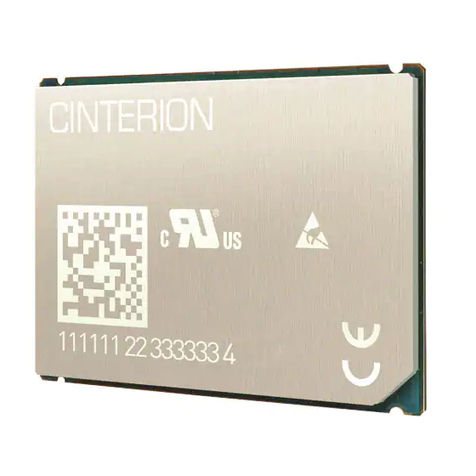
Gemalto
Gemalto Cinterion EMS31-V Installation guide
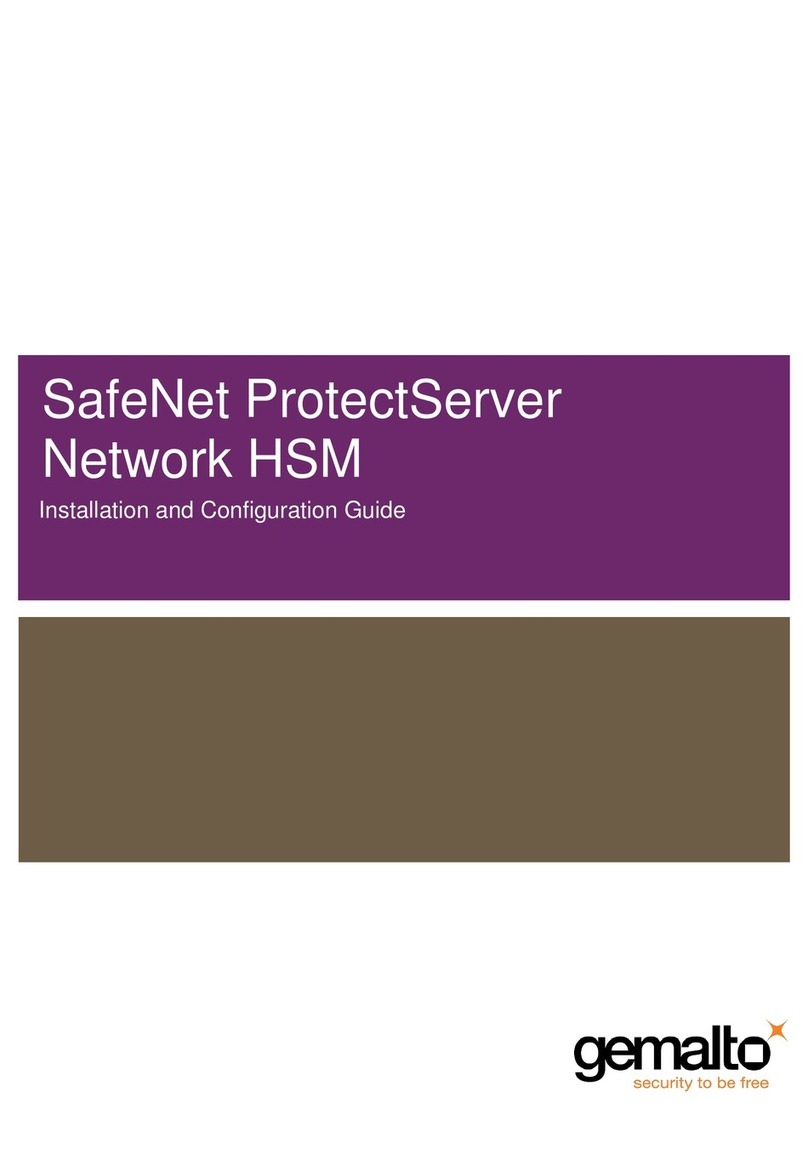
Gemalto
Gemalto SafeNet ProtectServer Operator's manual
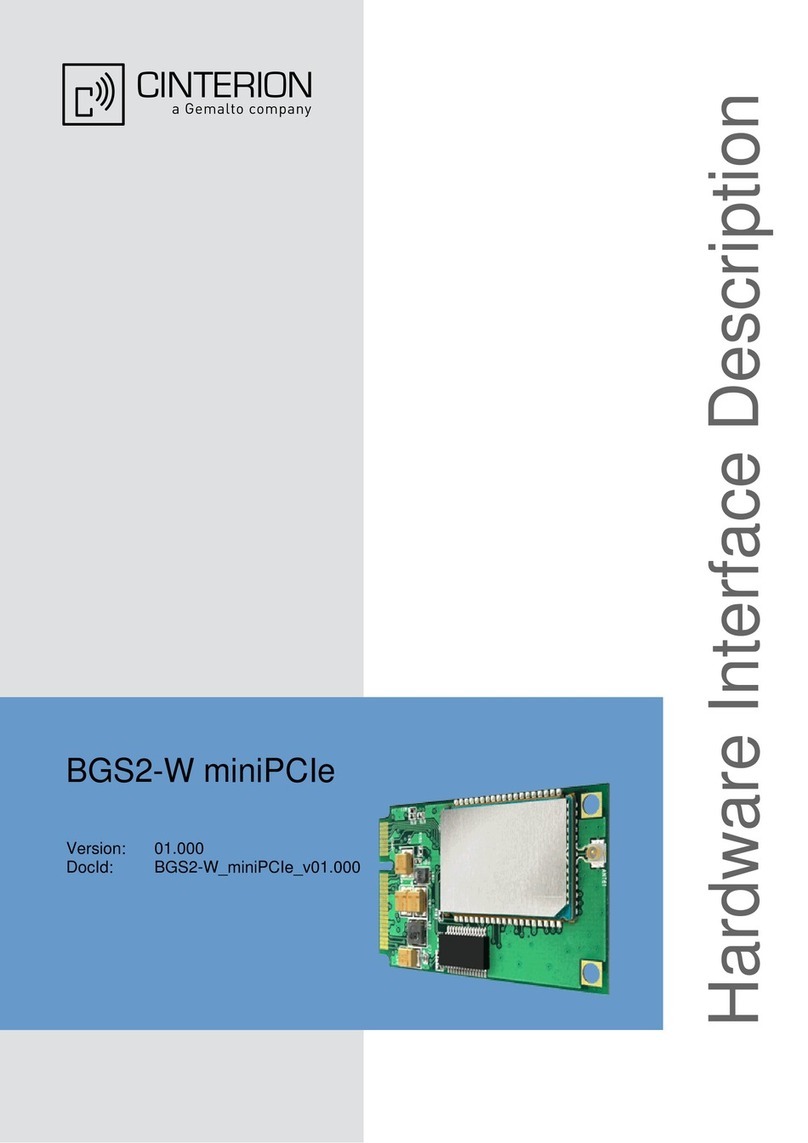
Gemalto
Gemalto Cinterion BGS2-W miniPCIe User manual
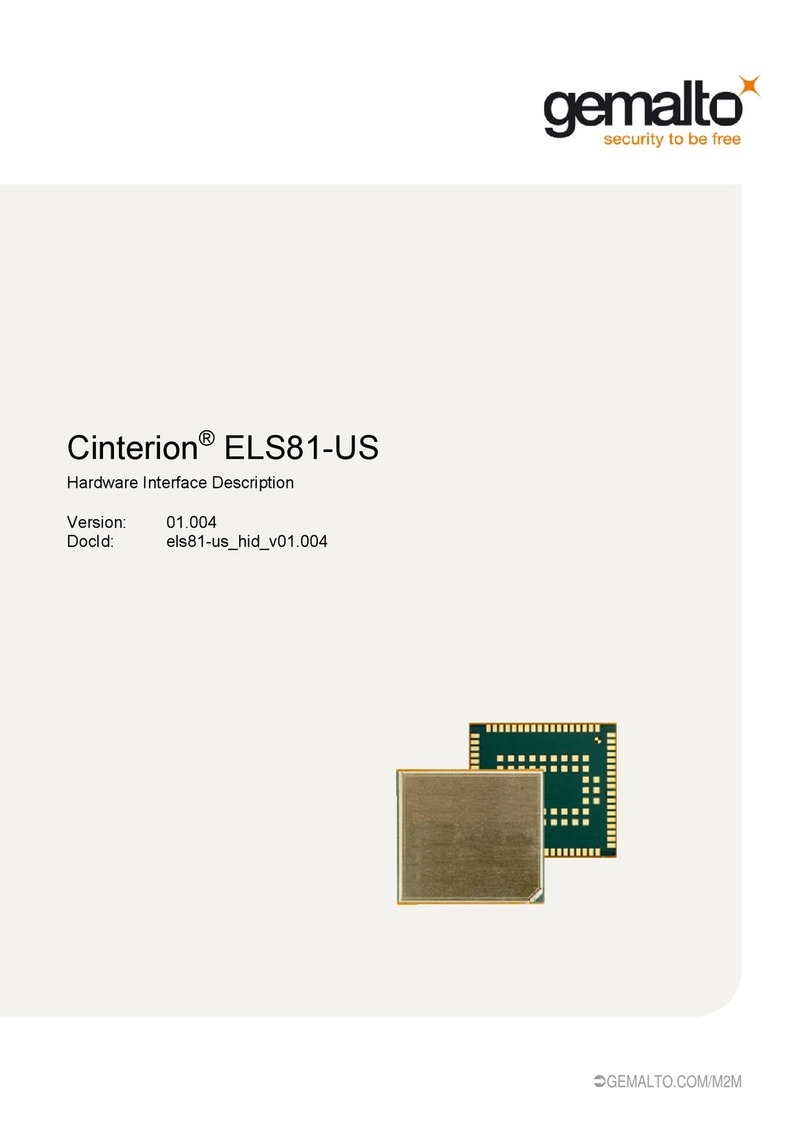
Gemalto
Gemalto Cinterion ELS81-US User manual
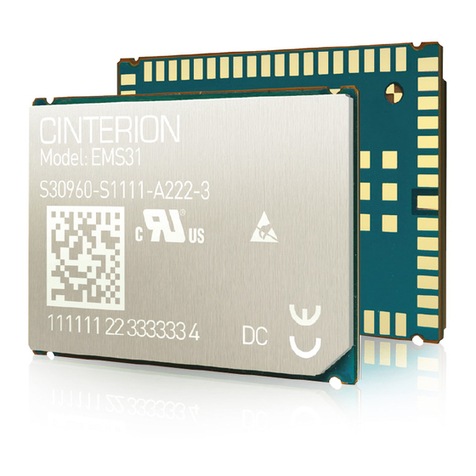
Gemalto
Gemalto Cinterion EMS31 User manual
